Obsidian comes in a staggering range of colors and shapes, it can be hard to keep up! This volcanic glass is far from a simpler mineraloid, it opens up a family of “stones” that have an incredible variety of colors and optical effects.
Want to learn some more? Let’s dive right in with some colors and patterns that occur in obsidian, and then we’ll have a word about the counterfeit glass on the market as well!
- 5 Interesting Facts About Obsidian!
- 9 Best Places Where Obsidian Can Be Found In The United States
- How To Polish Obsidian By Hand
Varieties of Obsidian
The following are different varieties of the mineral with no attention to form. There are certainly more varieties out there, but this will cover the vast majority of real obsidian on the market.
1. Black Obsidian
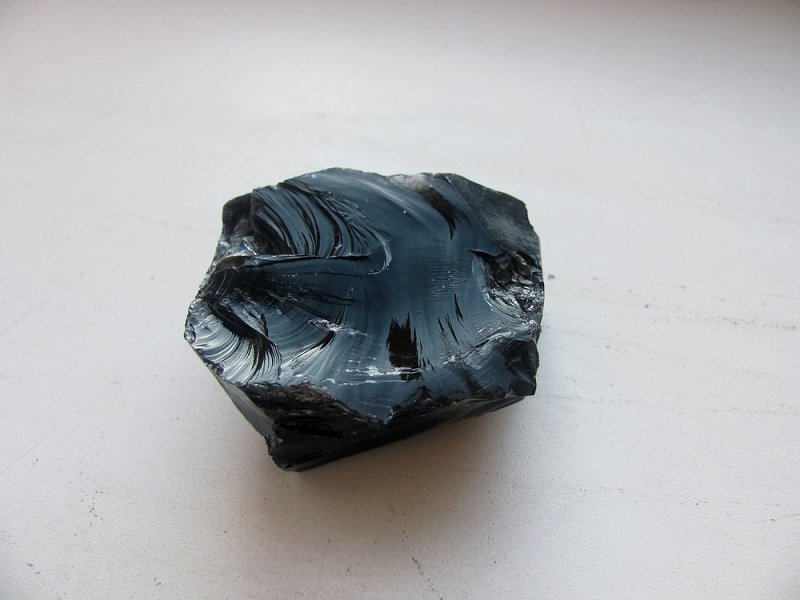
Black obsidian, or just obsidian, is a volcanic glass. The coloration actually occurs from nanoparticles of oxidized iron trapped in the obsidian’s structure, but most obsidian has some degree of translucency.
Obsidian isn’t actually a rock, we’re being quite literal when we refer to it as a glass. The majority of obsidian is at least 70% silica by weight, but it lacks the crystalline structure we see in quartz or even in microcrystalline stones like chalcedony.
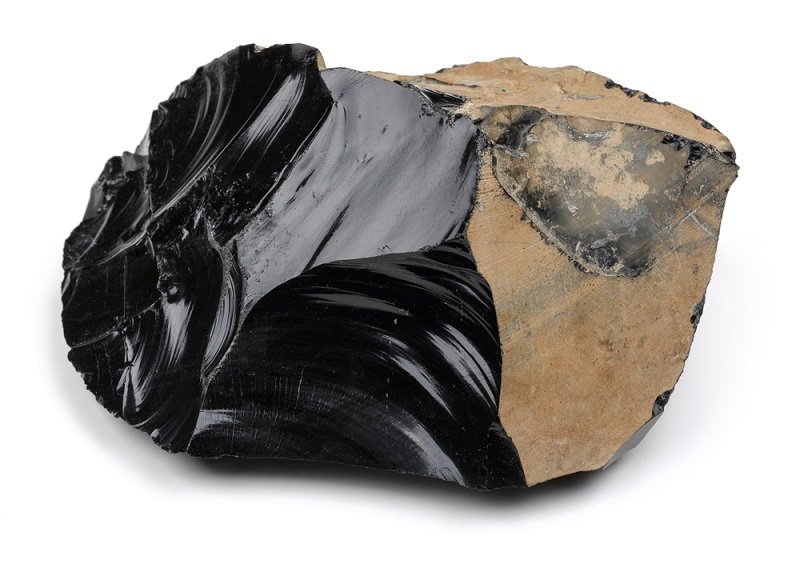
Obsidian can form an edge that makes razors look dull because it’s a glass. When struck at the right angle, the material exhibits a wave-like effect that separates a flake in a round pattern from the point of impact. This is known as a conchoidal fracture, and it’s the basis of obsidian’s tool use.
Black obsidian is readily available, and enormous deposits of it are spread across the Western portions of the United States. It’s use in jewelry is a bit limited, especially since it usually co-occurs with more exotic types of obsidian, but it’s a great material for decorative objects and has a timeless quality that many admire.
2. Rainbow Obsidian
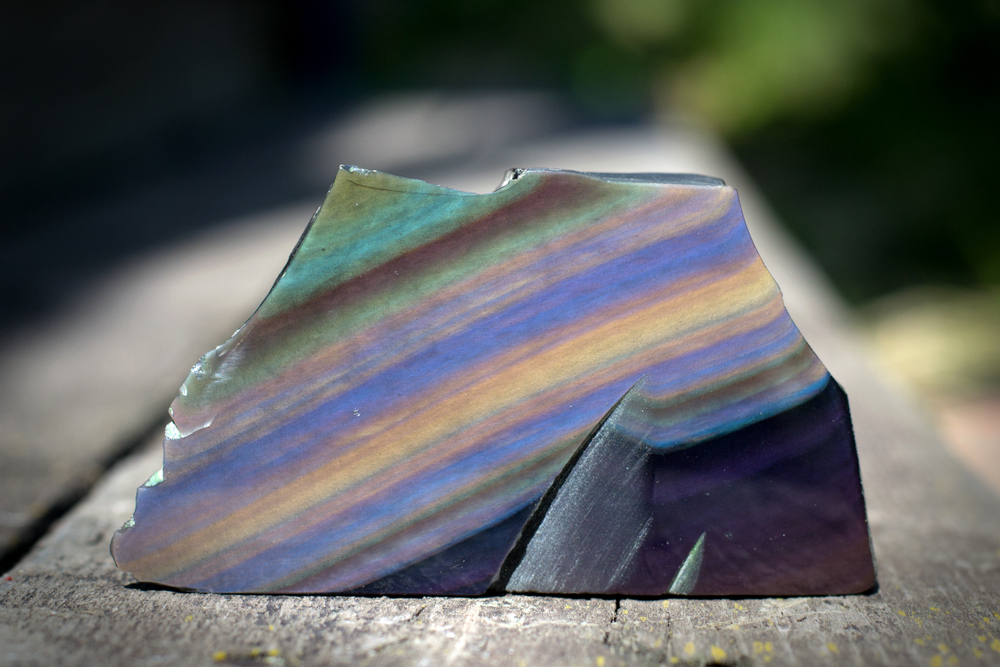
Rainbow obsidian is a variety that exhibits a rainbow pattern in concentric rings when the light hits the surface just right. Before the discovery of fire obsidian, which has a much more intense effect, it was among the most expensive types.
Rainbow obsidian is a prized material, varying greatly in colors. Some of the most striking examples are found in the aptly named Rainbow Mine in the Warner Mounts area. Rainbow obsidian can range from full-facing, incredible pastel colors to a barely visible sheen form an oblique angle.
The cause of this coloration? Nano-rods of hedenbergite. This mineral is oriented in the rainbow obsidian and causes light entering the stone to act differently. This effect is caused by thin-film interference, think of it as a solid oil slick effect.
Rainbow Obsidian is the second most expensive type of obsidian most of the time, but it’s very affordable compared to Fire Obsidian. There are great places to find it in each state along the Western Coast of the USA, and some great examples also come from Mexico.
3. Sheen Obsidian
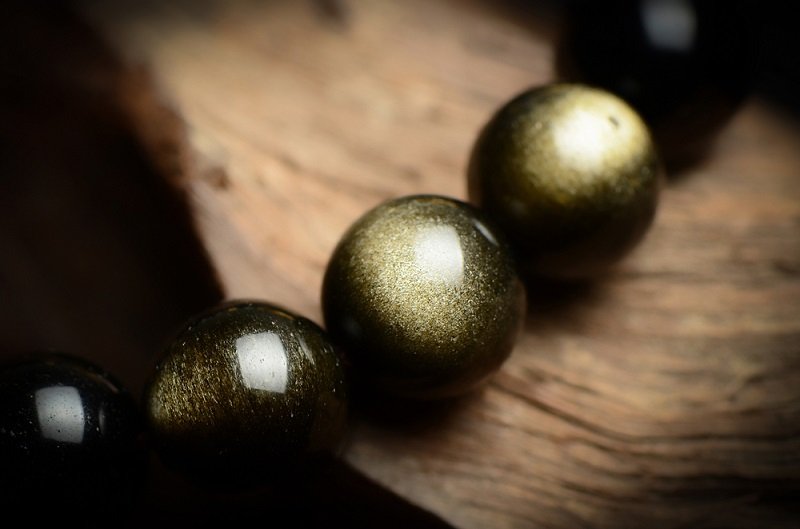
Coming in both gold and silver varieties, sheen obsidian has a distinctive effect that makes the surface look a bit more alive. The effect is similar to the chatoyancy found in Tiger’s Eye, although the cause is different. There’s just no room for fiber growth in the rapidly cooling material that becomes obsidian.
Sheen obsidian’s optical effect is created by the inclusion of gas bubbles in the stone. These microbubbles are aligned in a way that they create the illusion of gold or silver shine underneath the surface of the stone.
Sheen obsidian is among the rarer varieties, but it’s readily available for collectors. Pieces range from appearing entirely in a metallic shade when viewed from the front to just small hints of activity under the surface from specific angles.
Sheen Obsidian is a strange one since the effect is essentially created by small pockets that don’t have obsidian in them. That said, it’s beautiful when cut properly and there’s a reason it’s remained a fast favorite among collectors.
4. Fire Obsidian
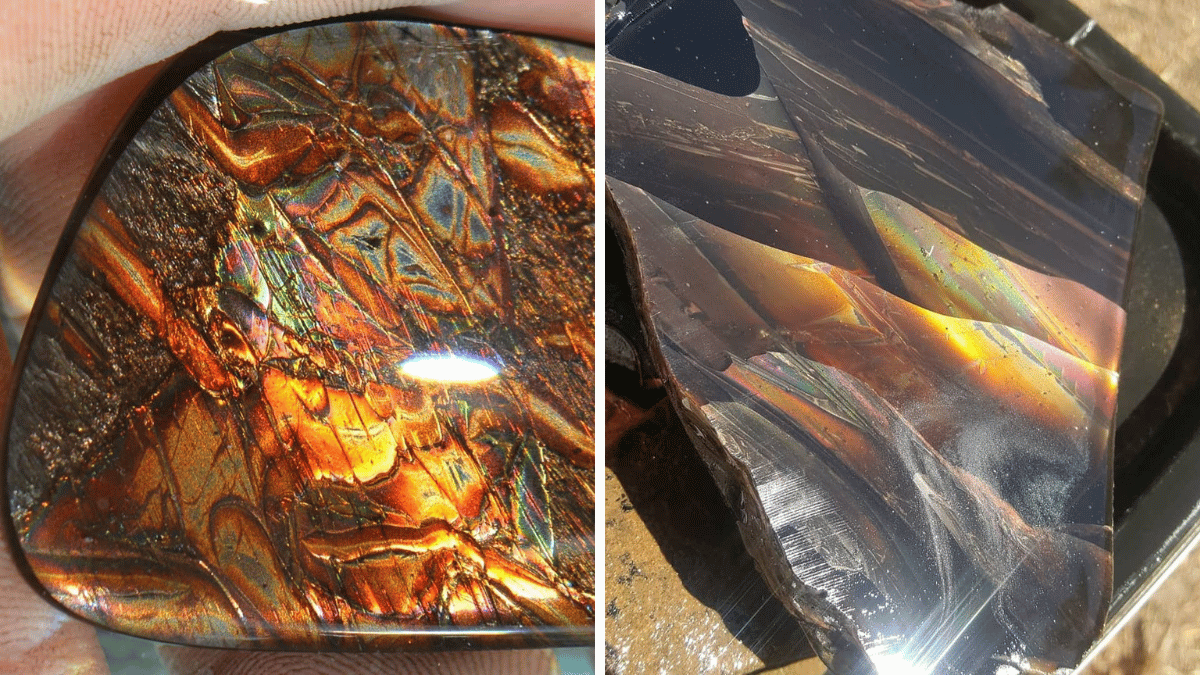
Fire obsidian is… something else. It’s the most expensive and rare type of obsidian and requires a ton of experience to cut properly to view the visible effect. When it’s cut properly, fire obsidian will show an incredible array of bright colors when viewed from the proper angle.
Fire obsidian’s effect is created through thin-film interference, much like rainbow obsidian, but the material here is ultra-thin layers of magnetite instead of the hedenbergite that causes the colors in rainbow obsidian.
Fire obsidian is extremely expensive compared to most varieties. It’s usually sold per carat, as opposed to every other variety which is sold by the pound or piece depending on how much work has been put into the rough.
Fire obsidian is only found in a few places and if there’s anywhere else… people are staying tight-lipped about it. In an interesting way, fire obsidian is one of the peak challenges of the lapidary arts. The careful attention to angle when cutting, and the inherent difficulty of polishing obsidian, can combine to create incredible beauty or destroy the fire entirely.
5. Snowflake Obsidian
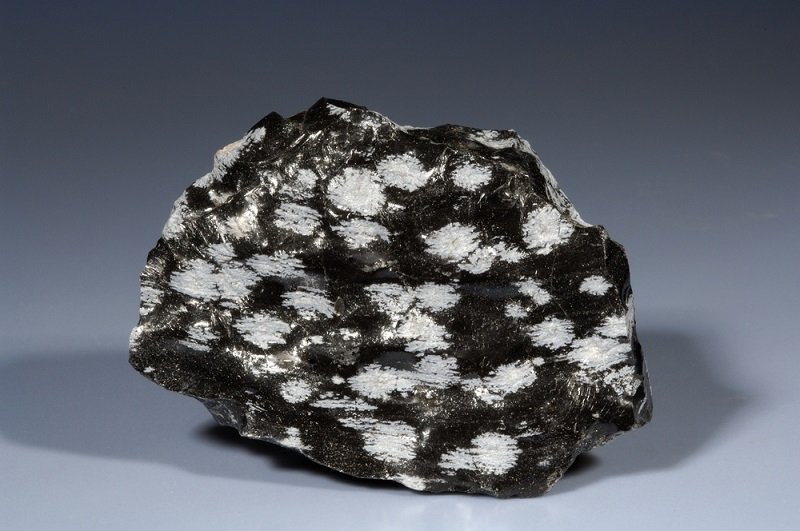
Snowflake Obsidian is one of the more common varieties of decorative obsidian you’ll run into. Its defining feature is a rich back background broken up by delicate white stars or snowflakes that appear in complex configurations.
The snowflakes in this variety are caused by spheroid crystals of cristobalite, which is a form of quartz. When you cut into or break these spheroids you end up with the patterns seen on the surface of this obsidian.
Snowflake obsidian often occurs in massive pieces, which makes it suitable for a wider variety of objects than most stones. While it’s most often cut for jewelry, larger pieces have been made into bowls, statues, and other decorative objects a bit larger than a pendant.
Snowflake obsidian’s pattern is solid, showing equally from all angles. The unique appearance and stark contrast have made it quite popular with collectors, and it’s among the more common varieties of this volcanic glass.
6. Mahogany Obsidian
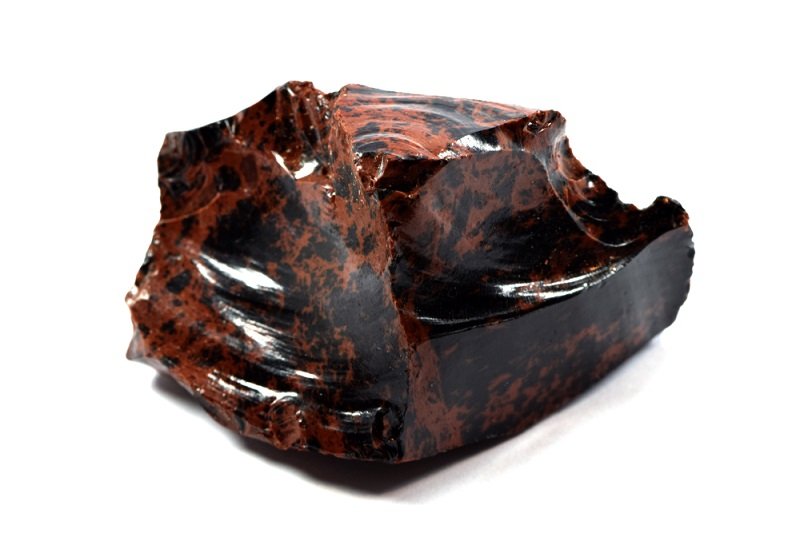
Mahogany obsidian bears deep red-brown patterns and streaks across the black surface of the material. These can range from large splashes to more intense and intricate banding depending on the individual sample but it’s another common variety used for more than just jewelry.
The coloration in mahogany obsidian is thought to come from hematite included in the glass as it cools. This leads to the large, rust-colored bands and spots in the stone. You’ll sometimes hear this variety referred to as red obsidian, which… isn’t great but it’s better than most of the material sold under that name.
Mahogany obsidian is quite common. It’s used in jewelry, and decorative objects. It’s even a favorite among flintknapper. The latter can take advantage of the patterns to create wonderful knives and arrowheads which are accented by the internal coloration.
Mahogany obsidian deserves a place on every obsidian collector’s shelf. It’s easy to find, rather cheap, and incredibly attractive for something which can seem so simple at first glance.
Unique Obsidian Formations
Not everyone collects obsidian based on the variety. There are some rare forms of it out there available in only a few locations that people often try to collect. The following isn’t a 100% comprehensive overview, but it covers the vast majority of unique formations that can be found.
1. Apache Tears
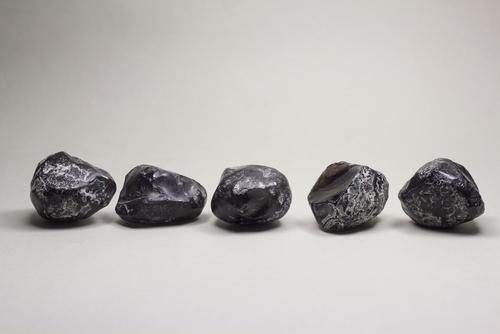
Small, rounded nodules of obsidian can be found in the desert. These are often known as Apache Tears, and they’re found eroded out of the ground in areas in Nevada and the Western US States. While not “rare” they do only occur in some tertiary volcanic zones.
These stones are closely associated with perlite, which is a hydrated silica form. When it doesn’t hydrate completely, you’re left with a roundish core of obsidian that displays onion-like layers. In other words: the perfect collector’s rock.
Apache tears are highly collectible and are often found in
2. Pele’s Hair
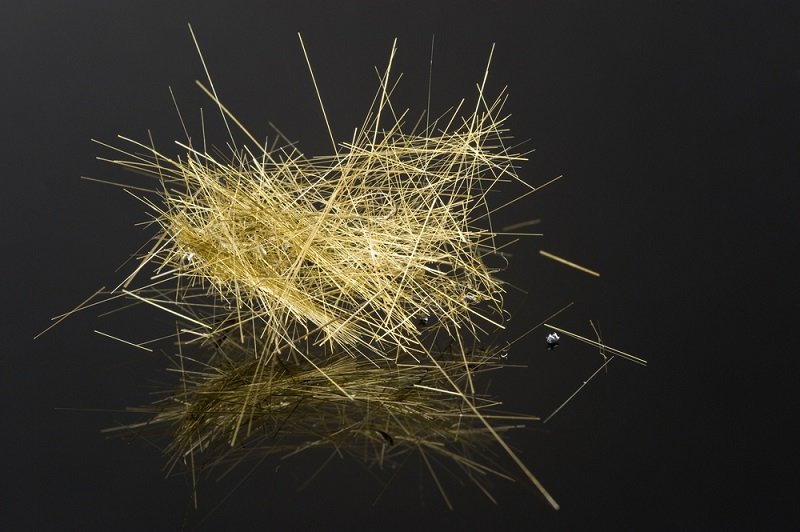
Pele’s Hair is incredible. It’s a unique form of volcanic glass which forms during certain types of volcanic activity. The hairs are… well, they’re hairs made of quickly cooled silica and they’re light enough to go airborne.
Pele’s Hair is named for the fiery volcanic goddess of Hawaii, where many unique forms of obsidian can be found. The hair can often be seen gathered on places like electric poles. It’s not advised to reach out and grab a handful, the material is very thin and retains obsidian’s edge when it breaks.
It can be hard to find samples of Pele’s Hair due to the fragility of the material and how much of a pain it is to handle. Still, it stands out as one of the more unique forms of volcanic glass and earned its place on this list.
3. Obsidian Needles
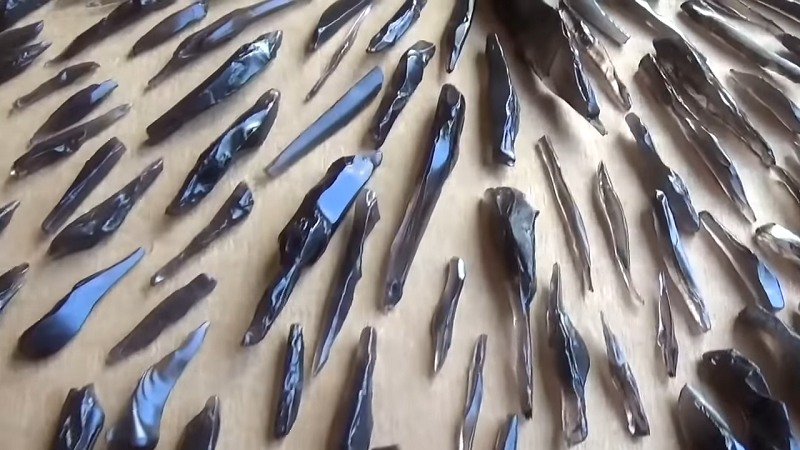
A very rare deposit, that seems to only occur in California, obsidian needles are elongated pieces of glass. They have a very unique, distinctive shape to them that appears to have occurred when they were thrown from the volcano initially.
Obsidian needles aren’t rare in the one area they exist, but there appear to be some specific conditions that allow their formation. Specifically, they appear to be the result of natural fractures that have then been weathered down to remove the edges.
These samples are readily available online and can be found easily by amateur hunters in the Davis Creek Needles Mine. They can occur as a few different varieties of obsidian but they’re usually the simple black type. The best of these needles can be over a foot long, but most are in the 1-4” range.
4. Pele’s Tears
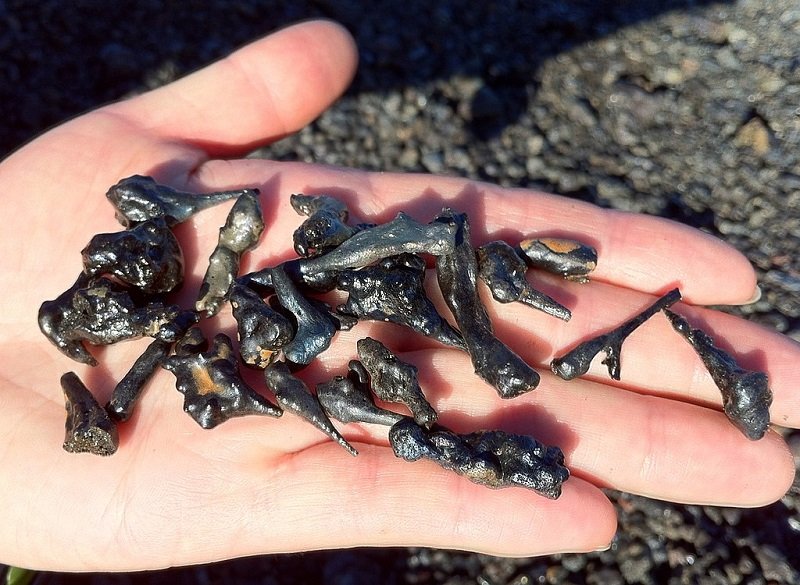
Distinct from Apache’s Tears, Pele’s Tears are an aerodynamically formed obsidian nodule. They occur when the material thrown from the volcano is cooling on the way down. This leaves us with a variety of small, irregularly shaped needles and nodules that are collectively known as Pele’s Tears.
These occur primarily in Hawaii and are often intermixed with Pele’s Hair. Seriously intermixed, as nanometer-sized formations of Pele’s Tears have been found in the cavities of Pele’s Hair. Studies indicate they’re formed in much the same way, but the end formation depends on the velocity of the eruption.
Pele’s Tears aren’t as readily available as many forms of obsidian, and taking rocks from the islands is seriously frowned upon. They’re still a unique formation of the stone, just one that should be admired and left in place instead of pocketed and brought back home.
A Word About Fake Obsidian Varieties
Obsidian, being a glass, lends itself well to various counterfeits and scams. Most serious amateur rockhounds know to check for bubbles in clear stones since they’re usually an indicator that the material is man-made.
Obsidian… not so much, since it’s actually glass and has bubbles naturally. The truth is that most glass-type “stones” are heavily counterfeited, whether it’s obsidian, moldavite, or any other natural glass formation.
The majority of fake obsidian available is offered in colorations that just don’t occur in nature. Red and green are the most common ones I’ve seen sold, usually highly transparent and deeply colored. The samples are attractive.
They’re also just man-made glass with a jacked-up price.
I didn’t note some existing varieties of obsidian above due to rarity and lack of real interest in the natural forms.
Green obsidian is a great example. Actual green obsidian is a dull-colored, opaque stone that hails from a few small areas in Mexico. A quick search on Google and the usual selling platforms show hundreds of examples of people selling what looks like bits of a melted green beer bottle as “green obsidian.”
Red obsidian is another fake variety that is commonly seen. It too is always high transparency colored glass. As noted above, red obsidian typically refers to Mahogany Obsidian. Specifically, it refers to pieces that are dominated by the reddish hematite inclusions that create the color of the glass.
Colored obsidian varieties exist, but they’re rare and inevitably opaque or have very low levels of translucency. The market is flooded with fakes in bold, primary colors and the sellers are just waiting to take your money.
My advice? If you’re looking at a piece of colored obsidian then look around to find the real deal. Even in rough form, it’s no guarantee, obsidian is a glass. Slag glass will take roughly the same shape due to that simple fact.
Buyer beware on colored obsidian, but for those who really want to dig deep into the obsidian well, there are some rare colored varieties out there. Just be aware that 95%+ of the market are colored glass looking for an expensive home.
- Online rock and mineral club for collectors of all levels!
- Find community with like-minded rock and mineral enthusiasts.
- Monthly Giveaways!
- Free Access to Entire Digital Library of Products (annual memberships)


